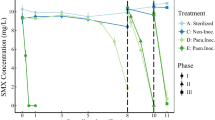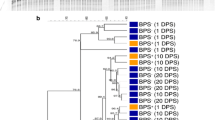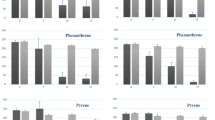Summary
Linear alkylbenzene sulfonate (LAS) is a widely used anionic surfactant. Although approximately 1 million metric tons of LAS are produced annually, relatively little is known about the bacteria or the genetic factors that control LAS degradation in the environment. The objectives of this research were to: i) compare bacterial populations in wastewater and pristine pond systems; ii) determine the frequency of plasmids in bacteria from these sites; and iii) compare the frequency of DNA sequences coding for aromatic catabolism in isolates from these two sites. Plate counts indicated that exposure to wastewater resulted in higher levels of both heterotrophic bacteria and bacteria capable of growing on LAS containing medium (LAS/YEPG). In addition to higher numbers, a higher proportion of heterotrophs from the wastewater system were capable of growth on LAS/YEPG medium. Thus, the high levels of LAS in the wastewater system apparently selected fro organisms that were able to tolerate and/or degrade, it. Mineralization of14C-ring labelled LAS in any habitat related to the presence of organisms that grew on LAS/YEPG. Although may of these isolates could carry out primary degradation, no isolate, could mineralize14C-ring LAS in pure culture. A higher incidence of plasmids was found in bacteria from the wastewater pond and among bacteria that grew on LAS containing medium. However, the presence of plasmid, DNA did not necessarily confer the ability to degrade LAS nor was the ability to degrade LAS dependent on the presence of a plasmid. The incidence of selected genotypes for aromatic catabolism was similar among isolates on LAS/YEPG at both sites, suggesting that LAS ring degradation may be present in other populations or encoded by alternative sequences. In conclusion, LAS mineralization is mediated by a consortium and the evidence that initial attack of LAS is plasmid mediated is inconclusive.
Similar content being viewed by others
References
Anderson, D.G. and L.L. McKay. 1983. Simple and rapid procedure for the isolation of large plasmid DNA from lactic Streptococci. Appl. Environ. Microbiol. 46: 549–552.
Broda, P., 1979. Plasmids. W.H. Freeman and Company Limited. San Francisco.
Burton, N.F., M.S. Day and T. Bull. 1982. Distribution of bacterial plasmids in clean and polluted sites in South Wales River. Appl. Environ. Microbiol. 44: 1026–1209.
Cain, R.B. 1981. Microbial degradation of surfactants and “builder” components. In: Microbiol Degradation of Xenobiotics and Recalcitrant Compounds. (T. Leisinger, A.M. Cook, R. Hutter and J. Nuesch. eds.) Academic Press pp. 326–370.
Federle, T.W. and G.M. Pastwa. 1988. Biodegradation of surfactants in saturated subsurface sediments. Groundwater pp. 761–770.
Federle, T.W. and R.M. Ventullo. 1990. Mineralization of surfactants by the microbiota of submerged plant detritus. Appl. Environ. Microbiol. 56: 333–339.
Fredrickson, J.K., R.J. Hicks, S.W. Li and F.J. Brockman. 1988. Plasmid incidence in bacteria from deep subsurface sediments. Appl. Environ. Microbiol. 54: 2916–2923.
Glassman, L.L., and L.A. McNichol. 1981. Plasmid frequency in natural populations of estuarine microorganisms. Plasmid 5: 231.
Hada, H.S. and R.K. Sizemore. 1981. Incidence of plasmids in marineVibrio sp. isolated from an oil field in the northwestern Gulf of Mexico. Appl. Environ. Microbiol. 41: 199–202.
Hanahan, D. and M. Meselson. 1981. Plasmid screening at high colony density. Gene 10: 63–67.
Harayama, S., M. Rekik, A. Wasserfallen and A. Bairoch. 1987. Evolutionary relationships between catabolic pathways for aromatics: Conservation of gene order and nucleotide sequence of catechol oxidation genes of pWWO and NAH7 plasmids. Mol. Gen. Genet. 210: 241–247.
Hardy, K. 1983. Bacterial Plasmids. American Society for Microbiology, Washington D.C.
Hermanson, M.G., G.W. Jones and S. Kjellberg 1987. Frequency of antibiotic and heavy metal resistance, pigmentation and plasmids in bacteria of the marine water interface. Appl. Environ. Microbiol. 53: 2338–2342.
Kado, C.I. and S.T. Liu. 1981. Rapid procedure for the detection and isolation of large and small plasmids. J. Bacteriol, 145: 1365–1373.
Leahy, J.G., C.C. Somerville, K.A. Cunningham, G.A., Adamatiades, J.J. Byrd and R.R. Colwell. 1990. Hydrocarbon mineralization in sediments and plasmid incidence in sediment from the Campeche Bank. Appl. Environ. Microbiol. 56: 1565–1570.
Maniatis, T., E.F. Fritsch and J. Sambrook. Molecular Cloning. Cold Spring Harbor Press. Cold Spring Harbor, N.Y.
Ogunseitan, O.A., E.T. Tedford, D. Pacia, K.M. Sirotkin and G.S. Sayler. 1987. Distribution of plasmids in groundwater bacteria. J. Indust. Microbiol. 1: 311–317.
Pettigrew, C.A., A. Breen, C. Corcoran and G.S. Sayler. 1990. Chlorinated biphenyl mineralization by individual populations and consortia of freshwater bacteria. Appl. Environ. Microbiol. 56: 2036–2045.
Rappaport, R.A. and W.S. Eckhoff. 1990. Monitoring linear alkyl benzene sulfonate in the environment: 1973–1986. Environ. Toxicol. Chem. 9: 1245–1257.
Sayler, G.S., S.W. Hooper, A.C. Layton and J.M.H. King. 1990. Catabolic plasmids of environmental and ecological significance. Microb Ecol. 19: 1–20.
Sayler, G.S., M.S. Sheilds, E.T. Tedford, A. Breen, S.W. Hooper, K.M. Sirotkin and J.W. Davis. 1985. Application of DNA-DNA colony hybridization to the detection of catabolic genotypes in environmental samples. Appl. Environ. Microbiol. 49: 1295–1303.
Swisher, R.W. 1987. Surfactant Biodegradation. Marcel Dekker Inc., New York, N.Y.
Werdelman, B.W. 1984. Tenside in unsere Welte-heute und morgen. pp. 3–21. In: Proceedings of the Second World Surfactants Congress, vol. 1. Syndicat National des Fabricants d'Agents de Surface et de Produits Auxiliaires Industriels, Paris.
Wickham, G.S. and R.M. Atlas. 1988. Plasmid frequency fluctuations in bacterial populations from chemically stressed soil communities. Appl. Environ. Microbiol. 54: 2192–2196.
Wittich, R.M., H.G. Rast and H.-J. Knachmus. 1988. Degradation of naphthalene-2,6-and naphthalene disulfonic acid by aMoraxella sp. Appl. Environ. Microbiol. 54: 1842–1847.
Author information
Authors and Affiliations
Rights and permissions
About this article
Cite this article
Breen, A., Jimenez, L., Sayler, G.S. et al. Plasmid incidence and linear alkylbenzene sulfonate biodegradation in wastewater and pristine pond ecosystems. Journal of Industrial Microbiology 9, 37–43 (1992). https://doi.org/10.1007/BF01576366
Received:
Accepted:
Issue Date:
DOI: https://doi.org/10.1007/BF01576366




